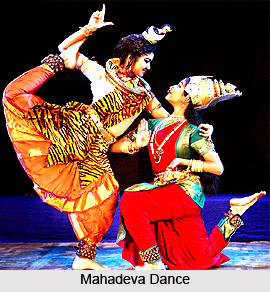 Mahadeva or Lord Shiva Dance is one of the most prominent dances of Bengal. This dance is usually performed in harmony with the character of Goddess Kali. The costumes for the dance are prepared by the local village artisans. The masks used in the Mahadeva dance are made by the village carpenter makes the masks which are later painted the potters of the village.
Mahadeva or Lord Shiva Dance is one of the most prominent dances of Bengal. This dance is usually performed in harmony with the character of Goddess Kali. The costumes for the dance are prepared by the local village artisans. The masks used in the Mahadeva dance are made by the village carpenter makes the masks which are later painted the potters of the village.
For the dance the performer wears a red loin cloth beneath while keeping his upper part of the body bare. He just smears some ashes in his bare body like that of Lord Shiva. The dancer also wears a double string of rudraksha seeds around his neck and on the head he puts on a back wig of black hair with two long locks extending upto the knees.
The performer before beginning his dance approaches the audience taking a mask in his hand. He then prostrates himself touching his head on the ground as an act of devotion. After he puts on the mask on the head two attendants tie the strings of the mask behind. They them give a trisul (trident) on his right hand and a conch-shell (shankha) in his left hand. The mask that he dancer puts on is made up of mango-wood while the surface of it is plastered with clay. When the clay dries up it is covered with dye, painting the surface with white colour and applying black for delineating of the features. The third eye of Shiva is also drawn on the forehead of the mask.
The dance depicts the ascetic spirit of Shiva. It is accompanied by the beating of the drums and sometimes by the chorus performance of the singers who sing devotional songs. The dance begins with slow stepping and gestures. Gradually the rhythmic movements assume a vigorous and dynamic form and the dancer gets carried away by the beatings of the drums and religious vigour. The performance finally concludes with a dramatic climax and the dancer retiring back.
This article is a stub. You can enrich by adding more information to it. Send your Write Up to content@indianetzone.com



















